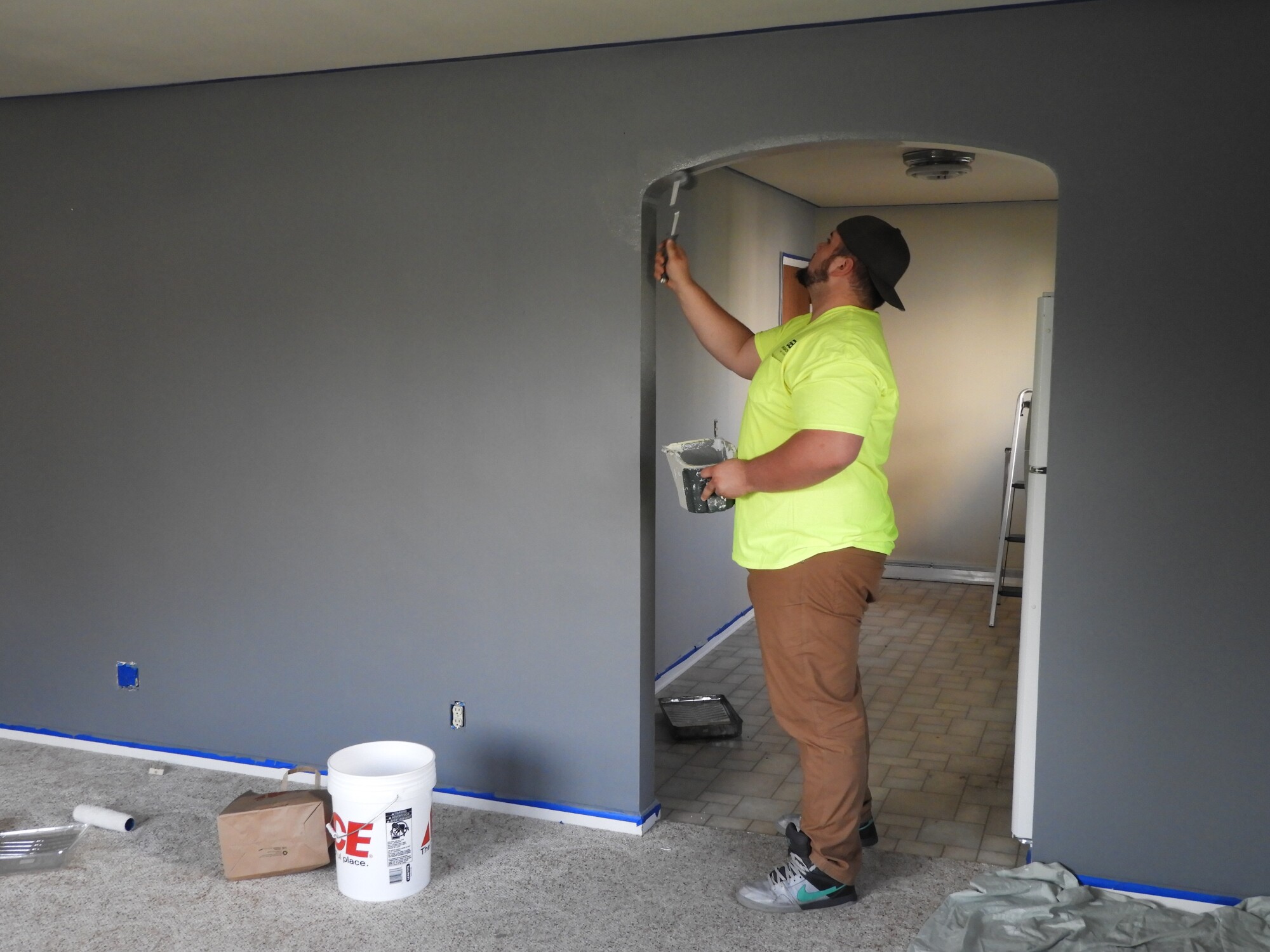
Painting Over Dark Walls? Here’s How to Get a Perfect Finish
Transforming a room by painting over dark walls can be a daunting task. Dark colors like deep blues, rich greens, or bold blacks make a striking visual impact, but when it’s time to switch to lighter shades, things can get tricky. Whether you’re going for a fresh, light neutral or a bright pop of color, covering dark walls requires a certain level of expertise and preparation to get a smooth, flawless finish. This is where hiring a professional painting service can make all the difference.
Painting Over Dark Walls: What You Need to Know
Painting over dark walls isn’t as simple as applying a coat of paint and calling it a day. Without the right techniques and materials, you could end up with streaky, uneven coverage, or worse, an unsightly mess that still shows traces of the original dark hue. While many homeowners opt for the DIY route, hiring a professional painter ensures that your new wall color comes out just as you envisioned—smooth, vibrant, and long-lasting.
In this blog, we’ll discuss the challenges of painting over dark walls and why hiring a professional painting service is often the best solution. We’ll also explore common painting mishaps that can be avoided with professional expertise, ensuring your home’s walls look perfect the first time.

The Challenges of Painting Over Dark Colors
Dark walls can add drama and sophistication to a room, but when it’s time to repaint, covering up those bold hues presents several challenges. Here’s a look at some of the main obstacles you’ll face when trying to paint over dark colors and why professional help can make a big difference.
1. Uneven Coverage
One of the biggest challenges when painting over dark walls is achieving even coverage. Dark colors, especially those with rich pigments, can show through multiple layers of lighter paint if not properly primed. Without the right approach, you may end up with patchy, uneven coverage that still shows hints of the previous color underneath. This is particularly true for lighter colors like white, beige, or pastel shades, which require more precision to ensure complete coverage.
Professional painters understand the nuances of coverage and know how to apply paint in a way that ensures uniform results. They use techniques like “back-rolling” and multiple thin coats to avoid streaks and roller marks, resulting in a flawless finish.
2. Bleeding Through
Bleeding occurs when the dark color underneath seeps through the new layers of paint, causing discoloration or an uneven tone in the new paint. This can be particularly frustrating for DIY painters who think they’ve applied enough coats, only to see traces of the old color reappearing after the paint dries.
To prevent bleeding, professional painters use high-quality primers specifically designed to block dark colors. Primers are a critical step in the process, as they create a neutral base that allows the new color to adhere properly and cover the old color fully. Without a proper primer, you may need multiple coats of paint to mask the dark color, which can be costly and time-consuming.
3. Streaky or Textured Finishes
Another common issue when painting over dark walls is the appearance of streaks, roller marks, or unwanted texture. If the paint isn’t applied evenly, or if the wrong tools are used, the new color may look streaky or bumpy, detracting from the overall look of the room.

Professional painters have the experience and equipment to apply paint evenly, avoiding these texture-related issues. They know how to select the right rollers and brushes for the job, ensuring a smooth, even finish across the entire wall. Plus, they’re skilled in maintaining consistent pressure and stroke techniques, which can be tricky for DIY painters.
Why Hiring a Professional Painting Service Is the Best Option
Painting over dark walls requires experience, precision, and the right materials. While DIY projects can be rewarding, painting is one task that’s often better left to the professionals—especially when covering dark colors. Here’s why hiring a professional painting service is the smartest decision for ensuring a perfect finish.
Expert Color Matching and Application
One of the key benefits of hiring a professional painter is their ability to perfectly match colors and ensure the new paint looks exactly as you envisioned. Professionals have access to high-quality paint and equipment, ensuring that your walls are painted with the right shade and finish.
Additionally, a professional will assess the condition of your walls and determine the best approach to achieve an even, vibrant color. They understand the nuances of paint types—whether it’s matte, satin, or gloss—and can recommend the best option for your space.
The Right Tools and Techniques
Painting over dark walls requires specialized tools and techniques, such as high-quality brushes, rollers, sprayers, and primers. Professional painters come equipped with everything they need to complete the job efficiently and to a high standard.
They also know how to handle challenging areas, such as tight corners, ceilings, and trim work, ensuring a polished, professional look throughout the room. Instead of struggling with subpar results using DIY tools, you can trust that professionals will use the right equipment for every aspect of the job.
Proper Surface Preparation
Before any paint can be applied, the surface of your walls must be properly prepared. This involves cleaning the walls, filling in cracks or holes, sanding rough patches, and applying primer. Professional painters handle all of this prep work for you, ensuring that the walls are smooth and ready to receive the new paint.
Proper surface preparation is crucial for achieving a durable, long-lasting finish. Skipping or rushing through this step can lead to peeling paint, uneven coverage, or other issues down the road. By hiring a professional, you can be confident that every step of the process is done right.

Time and Cost Efficiency
Painting an entire room or house can be time-consuming, especially when dealing with dark walls that require extra attention. Hiring a professional painting service saves you time and effort, as they work quickly and efficiently to complete the project. With their experience and equipment, they can often finish a job in a fraction of the time it would take a DIY painter.
While it may seem cheaper to paint the walls yourself, hiring a professional can actually save you money in the long run. DIY painters often underestimate how much paint they’ll need or end up spending more on additional coats, tools, or correcting mistakes. A professional ensures the job is done right the first time, eliminating the need for costly touch-ups or repaints.
Minimizing the Risk of Mistakes
Painting may seem simple, but there are plenty of ways a project can go wrong. Common painting mishaps include drips, roller marks, uneven edges, and smudging on trim or ceilings. These mistakes can ruin the final look of the room and require additional time and effort to correct.
Professional painters are trained to avoid these common errors and deliver flawless results. They know how to control paint application, maintain clean lines, and ensure even coverage across the entire surface. Plus, if something does go wrong, they’re equipped to fix it right away, sparing you the frustration of having to redo the work yourself.

Common Painting Mishaps Professionals Can Help You Avoid
While painting may seem straightforward, it’s easy to make mistakes that compromise the final result. Here are a few common painting mishaps that professional painters can help you avoid when tackling dark walls or any other painting project.
Skipping the Primer
One of the most common mistakes DIY painters make when painting over dark walls is skipping the primer. Primer is essential for covering dark colors and providing a solid base for the new paint to adhere to. Without it, you’re likely to end up with streaky coverage or need several extra coats of paint to get the desired result.
Professional painters know that a good primer is key to achieving a flawless finish. They’ll choose the right type of primer for your walls and ensure that it’s applied evenly before adding the topcoat.
Using the Wrong Type of Paint
Not all paints are created equal, and using the wrong type of paint can lead to a variety of issues. For example, if you use a flat or matte paint in high-traffic areas, the paint may wear down quickly and show stains or scuff marks. Similarly, using a high-gloss paint in the wrong space can highlight imperfections on the walls.
A professional painter will recommend the best type of paint for each room based on the function and the aesthetic you’re trying to achieve. They’ll also ensure that the paint is applied correctly for maximum durability and a beautiful finish.

Painting in the Wrong Conditions
Temperature and humidity can affect how well the paint adheres to the wall and how long it takes to dry. Painting in overly humid or cold conditions can lead to drips, uneven drying, or peeling paint. Professional painters are trained to assess the environment and adjust their approach accordingly, ensuring that the paint dries properly and adheres well.
Failing to Protect Surrounding Areas
A common DIY mistake is failing to properly tape and protect trim, floors, and furniture from paint splatters and drips. While it’s tempting to rush through the preparation, cutting corners on this step can lead to unwanted messes and additional cleanup later.
Professional house painters take the time to protect all areas of the room, using drop cloths, painter’s tape, and careful application techniques to ensure that the paint goes exactly where it’s supposed to—and nowhere else.
Rushing the Job
When you’re tackling a painting project on your own, it can be tempting to rush through it to get the job done quickly. However, rushing often leads to uneven coverage, drips, and other visible flaws. Professional painters know that patience is key to a flawless finish. They take the time to apply multiple thin coats, allow proper drying time between layers, and ensure that every inch of the wall is painted to perfection.
Painting over dark walls is a challenging task that requires proper preparation, techniques, and tools to achieve a flawless finish. While DIY painting may seem like a cost-effective option, it often leads to mistakes, wasted time, and frustration. By hiring a professional painting service, you’ll get the best results without the hassle.
